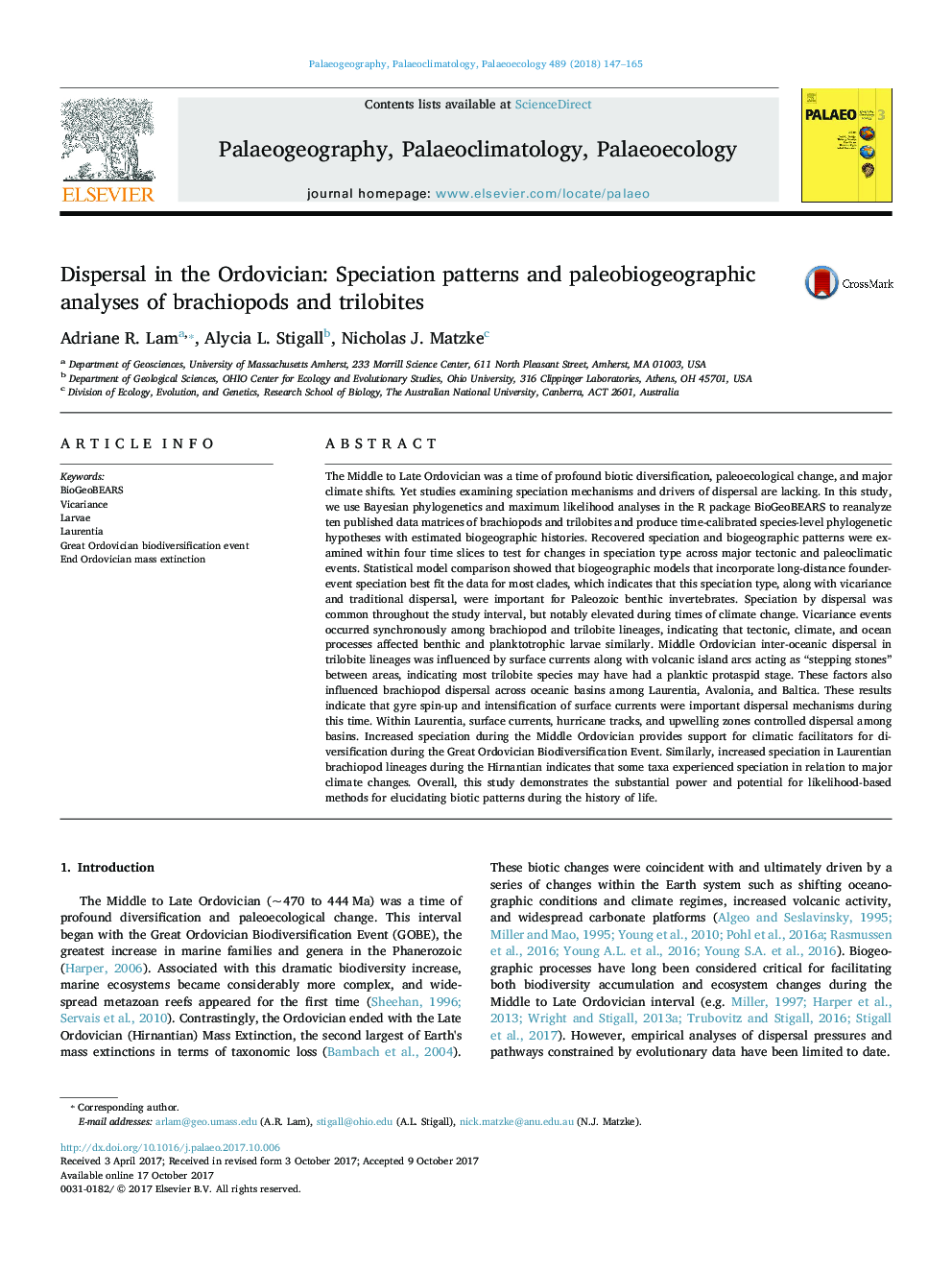| کد مقاله | کد نشریه | سال انتشار | مقاله انگلیسی | نسخه تمام متن |
|---|---|---|---|---|
| 8868509 | 1622103 | 2018 | 19 صفحه PDF | دانلود رایگان |
عنوان انگلیسی مقاله ISI
Dispersal in the Ordovician: Speciation patterns and paleobiogeographic analyses of brachiopods and trilobites
دانلود مقاله + سفارش ترجمه
دانلود مقاله ISI انگلیسی
رایگان برای ایرانیان
موضوعات مرتبط
مهندسی و علوم پایه
علوم زمین و سیارات
فرآیندهای سطح زمین
پیش نمایش صفحه اول مقاله

چکیده انگلیسی
The Middle to Late Ordovician was a time of profound biotic diversification, paleoecological change, and major climate shifts. Yet studies examining speciation mechanisms and drivers of dispersal are lacking. In this study, we use Bayesian phylogenetics and maximum likelihood analyses in the R package BioGeoBEARS to reanalyze ten published data matrices of brachiopods and trilobites and produce time-calibrated species-level phylogenetic hypotheses with estimated biogeographic histories. Recovered speciation and biogeographic patterns were examined within four time slices to test for changes in speciation type across major tectonic and paleoclimatic events. Statistical model comparison showed that biogeographic models that incorporate long-distance founder-event speciation best fit the data for most clades, which indicates that this speciation type, along with vicariance and traditional dispersal, were important for Paleozoic benthic invertebrates. Speciation by dispersal was common throughout the study interval, but notably elevated during times of climate change. Vicariance events occurred synchronously among brachiopod and trilobite lineages, indicating that tectonic, climate, and ocean processes affected benthic and planktotrophic larvae similarly. Middle Ordovician inter-oceanic dispersal in trilobite lineages was influenced by surface currents along with volcanic island arcs acting as “stepping stones” between areas, indicating most trilobite species may have had a planktic protaspid stage. These factors also influenced brachiopod dispersal across oceanic basins among Laurentia, Avalonia, and Baltica. These results indicate that gyre spin-up and intensification of surface currents were important dispersal mechanisms during this time. Within Laurentia, surface currents, hurricane tracks, and upwelling zones controlled dispersal among basins. Increased speciation during the Middle Ordovician provides support for climatic facilitators for diversification during the Great Ordovician Biodiversification Event. Similarly, increased speciation in Laurentian brachiopod lineages during the Hirnantian indicates that some taxa experienced speciation in relation to major climate changes. Overall, this study demonstrates the substantial power and potential for likelihood-based methods for elucidating biotic patterns during the history of life.
ناشر
Database: Elsevier - ScienceDirect (ساینس دایرکت)
Journal: Palaeogeography, Palaeoclimatology, Palaeoecology - Volume 489, 1 January 2018, Pages 147-165
Journal: Palaeogeography, Palaeoclimatology, Palaeoecology - Volume 489, 1 January 2018, Pages 147-165
نویسندگان
Adriane R. Lam, Alycia L. Stigall, Nicholas J. Matzke,